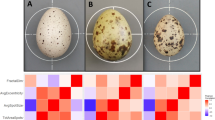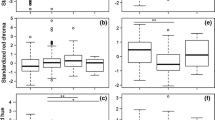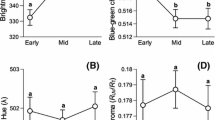Abstract
Studies of avian eggshell coloration have been a long-standing research focus in behavioral evolutionary ecology. Museum collections have provided a widely used resource because they allow efficient sampling across broad temporal, geographical, and taxonomic ranges, even for species that are rare and for which sampling in the wild is ethically or practically unwarranted. We used reflectance spectrophotometry across the avian visual spectrum to compare eggshell color of specimens of the song thrush (Turdus philomelos) in two museums (Natural History Museum, UK and Auckland Museum, New Zealand) with each other and with eggshells collected fresh in New Zealand. These data enabled us to test the effects of source and storage in different museums, as well as time since collection, across four metrics of eggshell coloration: blue-green and ultraviolet chroma, overall brightness, and the spectral coefficient of variation. Variation within an egg, within a clutch, and among clutches, was similar between the two museum datasets but different from those of fresh eggs. We found significant differences in all four metrics between the collections, and that fresh eggshells reflected stronger in the blue-green wavelength than in museum eggs. This difference is most likely due to different preservation techniques and storage histories. Furthermore, an effect of time since collection was only apparent in the blue-green chroma and was higher in more recent museum eggshell samples. Our results support the use of historic museum samples in intraspecific studies of shell coloration providing that efforts are made to compare specimens, which were collected during similar periods.




Similar content being viewed by others
References
Agnew N (1981) The corrosion of egg shells by acetic acid vapour. Australian Institute for the Conservation of Cultural Material (ICCM) Bulletin 7(2):3–9
Armenta JK, Dunn PO, Whittingham LA (2008) Effects of specimen age on plumage color. Auk 125:803–808
Avilés JM, Stokke BG, Moksnes A, Røskaft E, Møller AP (2007) Environmental conditions influence egg color of reed warblers Acrocephalus scirpaceus and their parasite, the common cuckoo Cuculus canorus. Behav Ecol Sociobiol 61:475–485
Bennett ATD, Thery M (2007) Avian color vision and coloration: multidisciplinary evolutionary biology. Am Nat 169:S1–S6
Birchard GF, Deeming DC (2009) Avian eggshell thickness: scaling and maximum body mass in birds. J Zool 279:95–101
Board RG, Perrott HR (1979) A Note on actinomycetes on a museum specimen of eggshell. J Appl Microbiol 47:539–541
Cassey P, Ewen JG, Blackburn TM, Hauber ME, Vorobyev M, Marshall NJ (2008) Eggshell colour does not predict measures of maternal investment in eggs of Turdus thrushes. Naturwissenschaften 95:713–721
Cassey P, Ewen JG, Marshall JN, Vorobyev M, Blackburn T, Hauber ME (2009) Are avian eggshell colours effective intraspecific communication signals in the Muscicapoidea? A perceptual modelling approach. Ibis 151:689–698
Cherry MI, Bennett ATD (2001) Egg colour matching in an African cuckoo, as revealed by ultraviolet-visible reflectance spectrophotometry. Proc R Soc B Biol Sci 268:565–571
Chilton G, Sorenson MD (2007) Genetic identification of eggs purportedly from the extinct Labrador Duck (Camptorhynchus labradorius). Auk 124:962–968
Cott HB (1940) Adaptive coloration in animals. Methuen, London
Doucet SM, Hill GE (2009) Do museum specimens accurately represent wild birds? A case study of carotenoid, melanin, and structural colours in long-tailed manakins Chiroxiphia linearis. J Avian Biol 40:146–156
Fischer H, Kögl F (1923) Zur Kenntnis der natürlichen Porphyrine IV. Über das Ooporphyrin. Z Physiol Chem 131:241–261
Gorchein A, Lim CK, Cassey P (2009) Extraction and analysis of colourful eggshell pigments using HPLC and HPLC/electrospray ionization tandem mass spectrometry. Biomed Chromatogr 23:602–606
Gosler AG, Barnett PR, Reynolds SJ (2000) Inheritance and variation in eggshell patterning in the great tit Parus major. Proc R Soc B Biol Sci 267:2469–2473
Gosler AG, Higham J, Reynolds SJ (2005) Why are birds’ eggs speckled? Ecol Lett 8:1105–1113
Green RE (1998) Long-term decline in the thickness of eggshells of thrushes, Turdus spp., in Britain. Proc R Soc B Biol Sci 265:679–684
Green R, Scharlemann JPW (2003) Egg and skin collections as a resource for long-term ecological studies. Bull Br Ornithol Club 123A:165–176
Hanley D, Heiber G, Dearborn DC (2008) Testing an assumption of the sexual-signaling hypothesis: does blue-green egg color reflect maternal antioxidant capacity? Condor 110:767–771
Hanley D, Doucet S, Dearborn DC (2010) A blackmail hypothesis for the evolution of conspicuous egg coloration in birds. Auk 127:453–459
Higgins PJ, Peter JM, Cowling SJ (eds) (2006) Handbook of Australian, New Zealand and Antarctic Birds, vol 7, Boatbill to Starling, Part B. Oxford University Press, Oxford
Hubbard JK, Uy JAC, Hauber ME, Hoekstra HE, Safran RJ (2010) Vertebrate pigmentation: from underlying genes to adaptive function. Trends Genet 26:231–239
Igic B, Greenwood DR, Palmer DJ, Cassey P, Gill BJ, Grim T, Brennan PL, Bassett SM, Battley PF, Hauber ME (2010) Detecting pigments from colourful eggshells of extinct birds. Chemoecology 20:43–48
Ito S, Tsudzuki M, Komori M, Mizutani M (1993) Celadon: an eggshell color mutation in Japanese quail. J Hered 84:145–147
Jagannath A, Shore RF, Walker LA, Ferns PN, Gosler AG (2008) Eggshell pigmentation indicates pesticide contamination. J Appl Ecol 45:133–140
Kilner RM (2006) The evolution of egg colour and patterning in birds. Biol Rev 81:383–406
Knox AG, Walters M (1992) Under the skin: the bird collections of the Natural History Museum. Bull Br Ornithol Club 112A:169–190
Krist M, Grim T (2007) Are blue eggs a sexually selected signal of female collared flycatchers? A cross-fostering experiment. Behav Ecol Sociobiol 61:863–876
Lack D (1958) The significance of the colour of Turdine eggs. Ibis 100:145–166
Lahti DC (2005) Evolution of bird eggs in the absence of cuckoo parasitism. Proc Natl Acad Sci USA 102:18057–18062
Lahti DC (2008) Population differentiation and rapid evolution of egg color in accordance with solar radiation. Auk 125:796–802
Lee PLM, Prys-Jones RP (2008) Extracting DNA from museum bird eggs, and whole genome amplification of archive DNA. Mol Ecol Resour 8:551–560
Lemberg R (1934) Bile pigments. VI. Biliverdin, uteroverdin and oocyan. Biochem J 28:978–987
Magige F, Moe B, Røskaft E (2008) The white colour of the Ostrich (Struthio camelus) egg is a trade-off between predation and overheating. J Ornithol 149:323–328
McNett GD, Marchetti K (2005) Ultraviolet degradation in carotenoid patches: live versus museum specimens of wood warblers (Parulidae). Auk 122:793–802
Mikšík I, Eckhardt A, Sedláková P, Mikulikova K (2007) Proteins of insoluble matrix of avian (Gallus gallus) eggshell. Connect Tissue Res 48:1–8
Moksnes A, Røskaft E (1995) Egg-morphs and host preference in the common cuckoo (Cuculus canorus)—an analysis of cuckoo and host eggs from European museum collections. J Zool 236:625–648
Moksnes A, Røskaft E, Rudolfsen G, Skjelseth S, Stokke BG, Kleven O, Gibbs HL, Honza M, Taborsky B, Teuschl Y, Vogl W, Taborsky M (2008) Individual female common cuckoos Cuculus canorus lay constant egg types but egg appearance cannot be used to assign eggs to females. J Avian Biol 39:238–241
Montgomerie R (2006) Analyzing colors. In: Hill GE, McGraw KJ (eds) Bird coloration: mechanisms and measurements. Harvard University Press, Harvard
Moreno J, Osorno JL (2003) Avian egg colour and sexual selection: does eggshell pigmentation reflect female condition and genetic quality? Ecol Lett 6:803–806
Moreno J, Morales J, Lobato E, Merino S, Tomas G, Martinez-de la Puente J (2005) Evidence for the signaling function of egg color in the pied flycatcher Ficedula hypoleuca. Behav Ecol 16:931–937
Moreno J, Lobato E, Morales J, Merino S, Tomas G, Martinez-de la Puente J, Sanz JJ, Mateo R, Soler JJ (2006) Experimental evidence that egg color indicates female condition at laying in a songbird. Behav Ecol 17:651–655
Oskam CL, Haile J, McLay E, Rigby P, Allentoft ME, Olsen ME, Bengtsson C, Miller GH, Schwenninger J-L, Jacomb C, Walter R, Baynes A, Dortch J, Parker-Pearson M, Gilbert MTP, Holdaway RN, Willerslev E, Bunce M (2010) Fossil avian eggshell preserves ancient DNA. Proc R Soc B Biol Sci 277:1991–2000
Polaciková L, Honza M, Procházka P, Topercer J, Stokke BG (2007) Colour characteristics of the blunt egg pole: cues for recognition of parasitic eggs as revealed by reflectance spectrophotometry. Anim Behav 74:419–427
Poole HK (1965) Spectrophotometric identification of eggshell pigments and timing of superficial pigment deposition in the Japanese quail. (302 M). Proc Soc Exp Biol Med 119:547–551
Pyke GH, Ehrlich PR (2010) Biological collections and ecological/environmental research: a review, some observations and a look to the future. Biol Rev 85:247–266
R Development Core Team (2009) R: a language and environment for statistical computing. R Foundation for Statistical Computing, Vienna
Reynolds SJ, Martin GR, Cassey P (2009) Is sexual selection blurring the functional significance of eggshell coloration hypotheses? Anim Behav 78:209–215
Ryhl-Svendsen M, Glastrup J (2002) Acetic acid and formic acid concentrations in the museum environment measured by SPME-GC/MS. Atmos Environ 36:3909–3916
Scharlemann JPW (2003) Are long-term declines in eggshell thickness of European birds related to acidification? Die Vogelwarte 4:69
Schönwetter M (1928) Anmerkungen zum Nehrkorn Katalog. Beitr Fortpflanzungsbiologie Vögel Berücksichtigung Oologie 4:49–53
Siefferman L, Navara K, Hill G (2006) Egg coloration is correlated with female condition in eastern bluebirds (Sialia sialis). Behav Ecol Sociobiol 59:651–656
Soler JJ, Moreno J, Aviles JM, Møller AP (2005) Blue and green egg-color intensity is associated with parental effort and mating system in passerines: support for the sexual selection hypothesis. Evolution 59:636–644
Soler JJ, Navarro C, Contreras TP, Aviles JM, Cuervo JJ (2008) Sexually selected egg coloration in spotless starlings. Am Nat 171:183–194
Solomon SE (1997) Egg and eggshell quality. Iowa State University Press, Annes
Starling M, Heinsohn R, Cockburn A, Langmore NE (2006) Cryptic gentes revealed in pallid cuckoos Cuculus pallidus using reflectance spectrophotometry. Proc R Soc B Biol Sci 273:1929–1934
Stoddard MC, Stevens M (2010) Pattern mimicry of host eggs by the common cuckoo, as seen through a bird’s eye. Proc R Soc B Biol Sci 277:1387–1393
Stokke BG, Moksnes A, Røskaft E (2002) Obligate brood parasites as selective agents for evolution of egg appearance in passerine birds. Evolution 56:199–205
Suarez AV, Tsutsui ND (2004) The value of museum collections for research and society. Bioscience 54:66–74
Underwood TJ, Sealy SG (2002) Adaptive significance of egg colouration. In: Deeming DC (ed) Avian incubation: behaviour, environment and evolution. Oxford University Press, Oxford, pp 280–298
Vikan JR, Stokke BG, Rutila J, Huhta E, Moksnes A, Røskaft E (2010) Evolution of defences against cuckoo (Cuculus canorus) parasitism in bramblings (Fringilla montifringilla): a comparison of four populations in Fennoscandia. Evol Ecol. doi:10.1007/s10682-010-9360-y
Wallace AR (1889) Darwinism: an exposition of the theory of natural selection with some of its applications. Macmillan, London
Walters M (2006) Colour in birds’ eggs: the collections of the Natural History Museum, Tring. Hist Biol Int J Paleobiol 18:141–204
Wang XT, Zhao CJ, Li JY, Xu GY, Lian LS, Wu CX, Deng XM (2009) Comparison of the total amount of eggshell pigments in Dongxiang brown-shelled eggs and Dongxiang blue-shelled eggs. Poult Sci 88:1735–39
Zhao R, Xu GY, Liu ZZ, Li JY, Yang N (2006) A study on eggshell pigmentation: Biliverdin in blue-shelled chickens. Poult Sci 85:546–549
Acknowledgements
We are extremely grateful to Douglas Russell, Robert Prŷs-Jones (NHM, Tring), and Brian Gill (Auckland Museum) for assisting us with access to museum collections. Doug Armstrong provided housing in New Zealand and Nikki MacArthur helped locate nests. An earlier version of this manuscript was considerably improved by constructive comments from László Garamszegi and two anonymous reviewers. This study would not have been possible without the practical support and advice of Rebecca Boulton. Funding was provided by a Leverhulme Trust Project Grant and a Human Frontier Science Program Young Investigator Grant to PC and MEH.
Conflict of interest
The authors declare that they have no conflict of interest.
Author information
Authors and Affiliations
Corresponding author
Additional information
Communicated by L. Garamszegi
Rights and permissions
About this article
Cite this article
Cassey, P., Maurer, G., Duval, C. et al. Impact of time since collection on avian eggshell color: a comparison of museum and fresh egg specimens. Behav Ecol Sociobiol 64, 1711–1720 (2010). https://doi.org/10.1007/s00265-010-1027-8
Received:
Revised:
Accepted:
Published:
Issue Date:
DOI: https://doi.org/10.1007/s00265-010-1027-8




